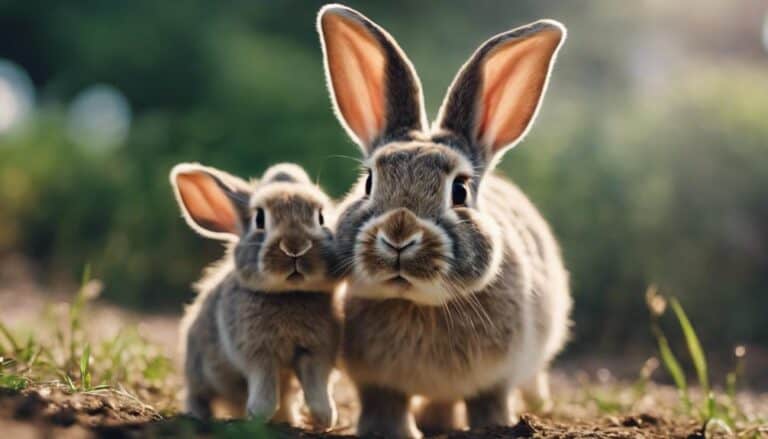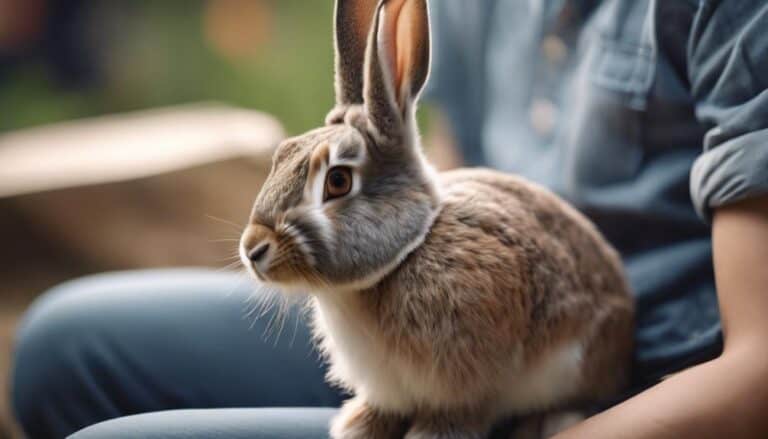So, have you ever stopped to think about why some animals, like kangaroos and rabbits, hop instead of walking? It’s not just about getting from point A to point B – this unique way of moving has been perfected over time for a specific reason. For instance, hopping allows these animals to cover more ground quickly while conserving energy, making it an efficient means of travel in their natural habitats. However, if you’ve ever wondered, “why is my bunny inactive,” it could be a sign that something is amiss or that they are simply resting, as they also need downtime just like any other creature. Understanding the reasons behind their unique locomotion can provide us with insights into their behaviors and well-being.
Hopping offers a mix of efficiency and agility that sets these creatures apart. But what makes it a better way to travel for some species? Let's dive into the fascinating evolutionary, biomechanical, and ecological reasons behind this intriguing behavior.
For starters, hopping can be really fast. Some animals can cover a lot of ground quickly, which is helpful when you need to escape predators or catch prey. It's also a great way to conserve energy – instead of using lots of little steps, you can use one big jump to cover more distance.
In some environments, like open spaces or deserts, hopping can be a more practical way to get around. It allows animals to quickly move across large areas while keeping an eye out for potential threats. And, of course, it's also a great way to jump over obstacles like rocks or bushes.
So, there you have it – the reasons why some animals hop instead of walking. It's not just a quirky habit; it's a clever adaptation that has helped these creatures thrive in their environments.
Contents
- 1 Key Takeaways
- 2 Evolution of Hopping in Animals
- 3 Benefits of Hopping Vs. Walking
- 4 Bipedal Hopping Mechanics
- 5 Hopping for Predator Escape
- 6 Hopping as Communication
- 7 Terrain Adaptation Through Hopping
- 8 Energy Efficiency of Hopping
- 9 Hopping in Different Animal Species
- 10 Hopping Behavior in Nature
- 11 Conclusion
Key Takeaways
So, why do some animals hop instead of walking? Well, for starters, hopping is a great way to conserve energy. It allows animals to cover long distances with minimal effort.
When it comes to escaping predators or catching prey, hopping is ideal. It's fast and allows for quick acceleration. In fact, hopping is more energy-efficient than walking, enabling animals to move faster using less energy.
Some animals, like kangaroos, have specialized tendons and muscles that help them store energy elastically. This makes their hopping even more efficient.
It's likely that animals developed hopping as a way to survive in open environments. Evolutionary pressures probably shaped them to use hopping as a way to get ahead.
Evolution of Hopping in Animals
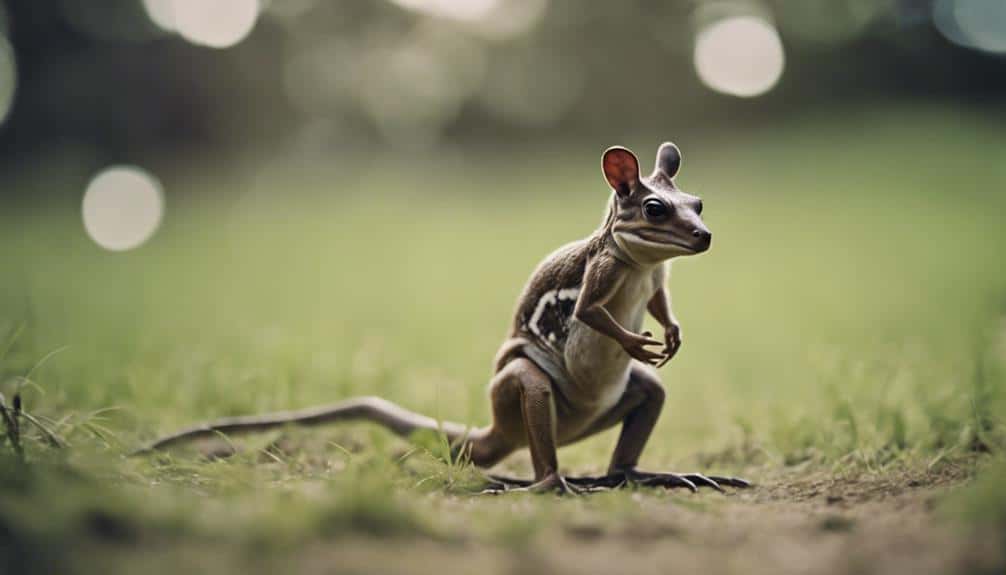
So, why do some animals hop? Well, it's because they need to cover a lot of ground in open spaces like deserts or grasslands, where there's not much to hide behind. To survive, they need to be able to move quickly and efficiently.
Hopping animals have developed some pretty cool features to help them do just that. They've strong back legs and special tendons that store energy and then release it, kind of like a spring. This lets them hop rapidly and for a long time without getting tired.
Over time, these special features have given hopping animals an edge. They can respond quickly to threats, catch prey, or escape from predators. The way their bodies are put together has driven some really interesting adaptations in different species. It's a great example of how the natural world works – form and function are closely tied together.
The evolution of hopping is a great example of how environmental pressures can shape the way animals move. In certain habitats, hopping is a really effective way to get around, and that's why we see it in so many different species.
Benefits of Hopping Vs. Walking
So, when it comes to getting around, hopping has some major advantages over walking – especially for small animals living in open spaces.
For one thing, hopping is way more energy-efficient. When animals hop, they use the elastic energy stored in their tendons and muscles, which means they don't have to burn as much fuel to get where they're going. This means they can cover a lot of ground without getting tired out.
Take kangaroos, for example – they can hit speeds of up to 70 kilometers per hour just by hopping! That makes them super effective predators and helps them make a quick getaway when they need to.
But that's not all. The way hopping works also makes it way more agile and maneuverable. This is super important for animals living in tough environments where they need to be able to dodge and weave to survive.
And let's not forget that hopping is perfect for certain environments, like the Australian outback, where animals need to travel long distances to find food and water.
All in all, hopping is a great way for small animals to get around in open spaces – it's fast, it's efficient, and it helps them stay alive.
Bipedal Hopping Mechanics
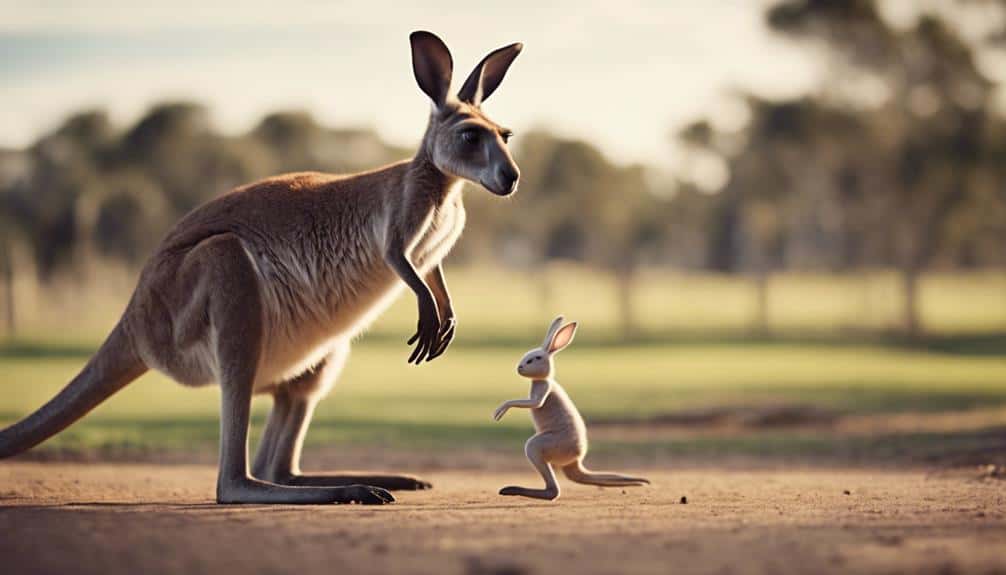
When it comes to getting around quickly, small animals have a clever trick up their sleeves: bipedal hopping. This way of moving is all about using muscles in a special way to store and release energy, kind of like a spring. In birds, for example, this means using their leg muscles to propel themselves forward.
As a bird gets ready to hop, its leg muscles stretch out tendons and ligaments, storing up energy like a coiled spring. Then, when it pushes off the ground, that energy is released, sending the bird flying forward. While it's in the air, its muscles work to keep its body stable and control the direction of the hop.
When it lands, its legs absorb the impact, reducing the stress on its skeleton.
What's really cool about bipedal hopping is that it's not just fast – it's also super efficient. By using their muscles like springs, birds can hop around without using up too much energy. This is really helpful for small animals that need to cover short distances quickly.
It's like having a built-in pogo stick!
Hopping for Predator Escape
When small animals sense danger, they often rely on their remarkable ability to hop as a quick way to escape predators. This technique is commonly seen in birds and other animals as a survival strategy.
Hopping allows them to rapidly change direction, making it tough for predators to anticipate their next move. The swift, erratic movements during hopping make it challenging for predators to maintain a focused pursuit.
Hopping not only helps animals dodge predators but also gives them a height advantage. By jumping up, they can get a better view of their surroundings and spot potential threats earlier.
This allows them to plan their escape routes more effectively. Plus, hopping enables them to cover short distances rapidly, which is crucial when escaping from immediate danger.
The way animals hop plays a crucial role in escaping predators. They use their powerful hind legs to propel themselves forward, achieving bursts of speed that can outpace many predators.
What's more, hopping is energy-efficient, allowing animals to sustain their escape for longer periods compared to other forms of movement.
In the end, hopping is an essential tool in the survival kit of small animals when faced with predators.
Hopping as Communication
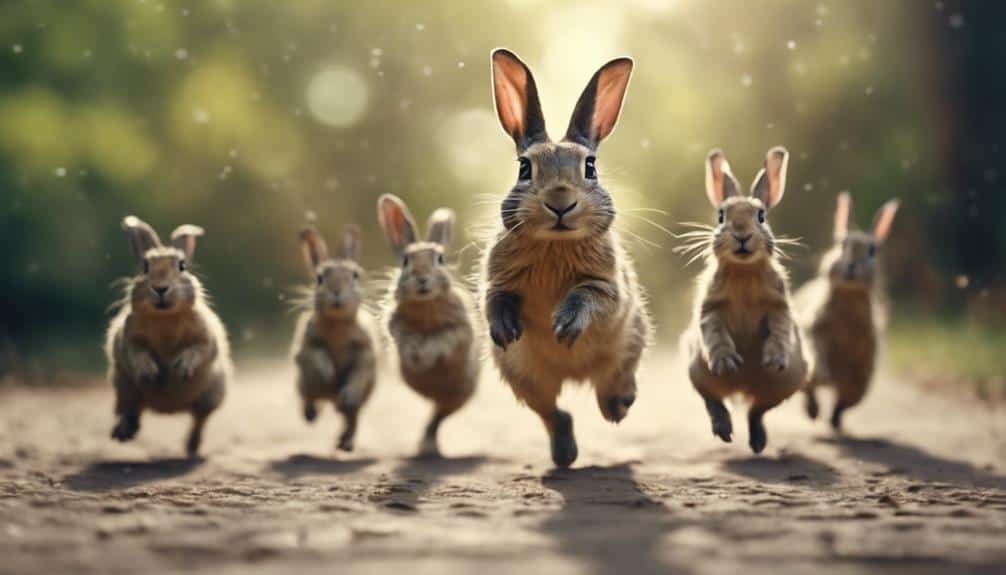
Small animals, especially birds, use intricate body language to convey information through their unique hopping patterns. This form of communication allows them to express various messages to their flock members and potential mates.
When birds hop around their territory, they're asserting dominance and marking their space. This deters potential intruders from entering their area.
During mating seasons, male birds take it to the next level by showcasing elaborate hopping displays to attract females. These displays demonstrate their vitality and genetic fitness, which is crucial for attracting a mate.
But hopping patterns can also signal danger. If a bird suddenly changes its hopping pattern, like rapid hops or erratic movements, it's warning other birds in the vicinity of potential predators. This alert system helps keep the flock safe.
Hopping isn't just about warning or attracting others, though. When birds participate in group hopping activities, where they synchronize their movements, it strengthens social bonds within the flock and maintains cohesion. This is essential for their survival and social interactions.
Through these hopping behaviors, small birds effectively communicate a wide range of information essential for their survival and social interactions.
Terrain Adaptation Through Hopping
Hopping is a really cool way that some animals move around. It's especially helpful when they're in environments with narrow perches and branches.
By hopping, they can navigate their surroundings with agility and precision. This way, they conserve energy while covering a lot of ground in just one hop.
One of the best things about hopping is that it allows animals to adapt to different terrains. They can move around easily and efficiently, which is super important for their survival.
In a way, hopping is like a special tool that helps them thrive in their ecological niche. It's a great example of how animals have evolved to fit in with their environment.
Terrain Hopping Benefits
So, when it comes to getting around, hopping is a super useful way for animals to move. It lets them cross all sorts of terrains efficiently and effectively, and that brings several benefits.
For one, hopping gives animals enhanced mobility. They can quickly cross uneven or challenging terrain, like rocky surfaces or dense vegetation, that might slow them down if they were walking.
Another perk is energy conservation. The way hopping works, it can reduce the energy animals need to spend to move around on rough terrain. This is because it uses elastic energy storage and release mechanisms, which is pretty cool.
Hopping also provides better stability on unstable surfaces like sand or snow. When animals hop, they can distribute their weight more evenly, which helps them stay balanced.
Lastly, hopping lets animals make quick escapes. They can move rapidly and unpredictably, which helps them dodge predators or quickly get across obstacles with agility and speed.
Efficient Movement Strategy
Some animals move around really efficiently. They've developed a special way of getting around called hopping, which helps them conserve energy and move quickly over tough terrain. Hopping is a great way for animals to cover long distances without getting too tired.
When they jump, they use the energy stored in their tendons and muscles, which means they don't have to work as hard to move around. This is super helpful when they're moving over rocky or sandy surfaces where walking or running would be really tiring.
One of the best things about hopping is that it lets animals move really fast and accelerate quickly. This is perfect for when they need to get away from predators or catch their next meal.
Some animals, like kangaroos, have even made hopping their main way of getting around. They can cover huge distances at high speeds without getting too tired, which helps them survive and thrive in their environment.
Energy Efficiency of Hopping
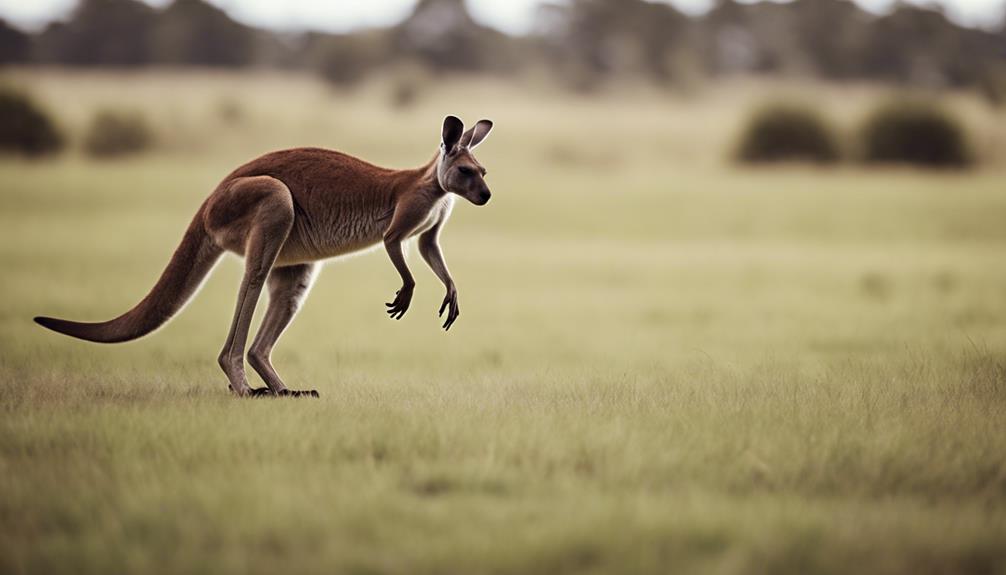
Hopping is actually a really energy-efficient way to move around, especially when you compare it to walking. One reason for this is that animals like kangaroos have super powerful leg muscles and specialized tendons.
These muscles and tendons work together to let the kangaroo cover a lot of ground while using less energy.
When the kangaroo hops, it stores energy in its tendons, kind of like a spring. Then, when it lands, that energy is released, which helps to propel it forward.
This process is called elastic energy, and it really helps reduce the amount of energy the kangaroo needs to use for each hop.
Hopping Vs. Walking Efficiency
So, have you ever wondered why some animals prefer to hop instead of walk? It's because hopping is actually way more energy-efficient than walking.
When animals hop, they can cover a lot of ground using less energy. For instance, they can travel up to 25 body lengths per second while using only half the energy required for walking. That's a huge difference!
Take kangaroos, for example. When they hop, they use about 0.25 joules of energy per kilogram per meter. But when they walk, they use around 1.5 joules per kilogram per meter – that's six times more energy!
One reason hopping is so efficient is that it allows animals to store energy in their muscles and tendons, kind of like a spring. Then, with each hop, they can reuse that energy, which contributes to their overall energy efficiency.
Even small birds like robins and sparrows benefit from hopping. They use around 30% less energy when they hop instead of walk, making it a more economical way for them to get around.
Benefits of Hopping
When animals hop, they're able to move around really efficiently. This is because they're using the energy stored in their tendons and muscles to help them jump. This means they don't have to use as much energy to get from one place to another, which is really helpful in places where food is scarce.
For example, kangaroos can cover a lot of ground with just one hop, and they only use a tiny amount of energy compared to if they were walking the same distance. This is because they're releasing the stored energy with each hop, which reduces the overall energy they need to move around. This makes hopping a really efficient way to get around.
Hopping also allows animals to move really fast over short distances. This helps them catch food and respond quickly to any dangers or opportunities that come their way. Overall, the efficiency of hopping gives animals a big advantage, which helps them survive in tough environments.
Hopping in Different Animal Species
When we look at how different animals move around, we can see that hopping is a common way for them to get around in certain environments and on specific perches. But why do they hop? Well, different animals hop for different reasons.
For birds that spend most of their time in trees, hopping is a no-brainer. It's faster and more energy-efficient on narrow branches compared to walking. They've even developed special movements like sidestepping, switch-sidling, or hopping to move around on those narrow perches.
Small bird species that live in trees tend to hop around, while larger birds with longer strides can move more efficiently by moving one leg at a time. And while most birds that walk on two legs walk or run with alternating strides, some birds, like passerines, typically hop. Although, there are some exceptions – larks and pipits, for example, use striding locomotion.
Hopping Behavior in Nature
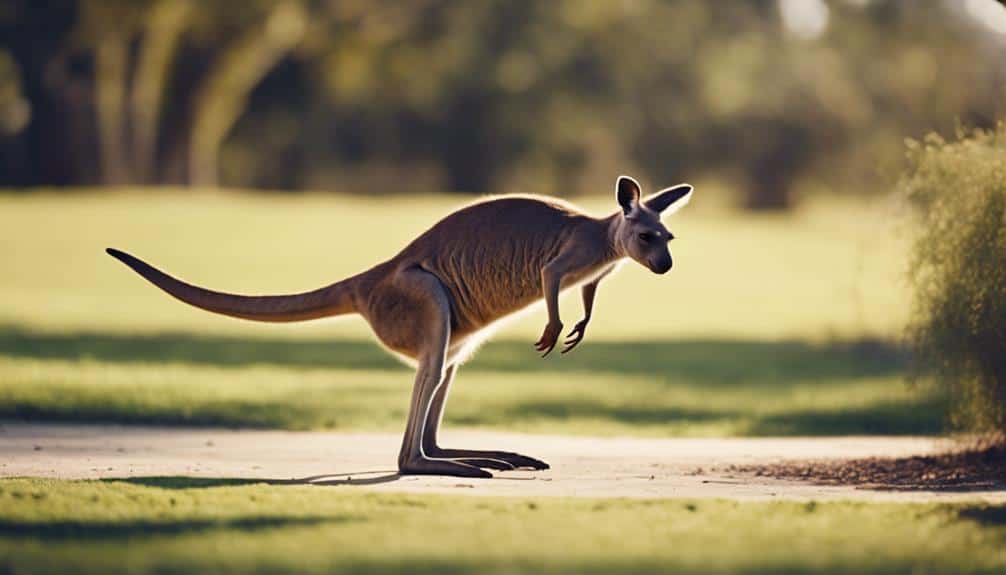
Have you ever watched birds on narrow perches? They've some amazing adaptations to help them navigate tight spaces. For example, they can sidestep, switch sides, and even use hopping movements like tightrope artists.
When birds have the space to move around freely, many of them walk or run with alternating strides. However, smaller birds that live in trees often prefer to hop instead. This is especially helpful for birds with short legs, as they can cover more ground with a single hop. On the other hand, larger birds with longer strides might find it more efficient to move one leg at a time.
But it's not just their anatomy that determines how birds move around. Speed and the situation they're in also play a big role. For instance, birds that usually hop might start running if they need to hurry. By studying how local bird species move in different contexts, we could learn more about what influences their choice between hopping and walking – both on perches and on the ground.
Conclusion
So, have you ever wondered why some animals hop instead of walking? It seems like a strange way to get around, but it's actually a really clever adaptation that helps them survive in their environments.
For one thing, hopping is a great way to conserve energy. When you hop, you're using your powerful leg muscles to propel yourself into the air, and then you're using gravity to bring you back down. This means you're not using as much energy as you'd if you were walking or running. This is especially helpful for animals that live in areas where food is scarce, because it means they can survive on less fuel.
Hopping is also really fast. Some animals, like kangaroos, can hop at speeds of up to 30 miles per hour. That's almost as fast as a car on the highway! This means they can quickly get away from predators or catch up to prey.
But hopping isn't just about speed and energy conservation. It's also a really agile way to move around. Animals that hop can change direction quickly and easily, which helps them navigate through dense forests or rocky terrain. And because they're airborne for part of the time, they can jump over obstacles that would be tricky to navigate on foot.
So, when you see an animal hopping around, just remember that it's not just a weird way of moving – it's a specialized technique that helps them survive and thrive in their environment.

